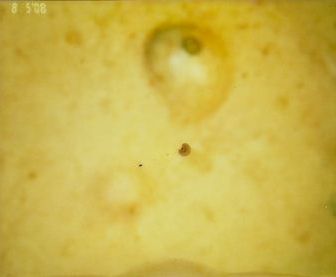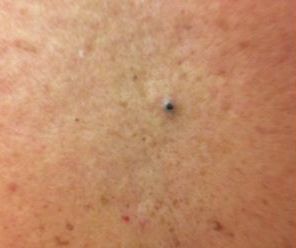Epidermoid Cysts Treated With Phosphatidylcholine Injections
Epidermoid cysts may be treated with intralesional injections of phosphatidylcholine to avoid potential recurrence, eliminate scarring, and reduce cost.

Figure 1.
Epidermoid cysts before treatment.
A 72-year-old man complained of slowly growing, painless lesions on his back. On physical examination, 2 contiguous, firm, hemispherical, nontender masses were found, with a black pore overlying each. The masses measured 3 x 2 cm and 2 x 2 cm (Figure 1). A clinical diagnosis of epidermoid cysts was made. The patient declined surgical excision but did consent to intralesional injections.
The cysts were injected once weekly for 3 consecutive weeks with 0.55 mL of a solution made with 1 mL of phosphatidylcholine (PPC) (100 mg) and 1 mL of lidocaine 2%. There was local redness and swelling at the injection site immediately following the injections, and the patient experienced a tolerable burning sensation; symptoms resolved after a few minutes. Originally firm, the cysts became soft and gel-like but remained encapsulated. The lesions decreased in size, with complete resolution by the fourth week.

Figure 2.
Resolution of epidermoid cysts 2 years after
treatment with injections of phosphatidylcholine.
The patient presented for periodic follow-up over 2 years without recurrence or mention of complications (Figure 2).
Discussion
Epidermoid cysts, also known as sebaceous or keratin cysts, are benign lesions that arise from ruptured pilosebaceous follicles that form dome-shaped keratin-filled sacs. An overlying pore or punctum, also known as a black head, is characteristic. Epidermoid cysts are most commonly seen on the face, neck, shoulders, and back. The overlying skin may become swollen and hyperemic.1
Left untreated, long-standing, chronically inflamed epidermoid cysts rarely can lead to cutaneous B-cell lymphoma2 or, in response to prolonged friction (eg, from clothing), they can become a necrotic ulcerative lesion that emits a foul odor.2
The conventional and widely practiced method of treatment for epidermoid cysts is surgical removal. Complete excision is required to avoid recurrence. Complete removal without rupturing the cyst capsule, however, is a challenge. There is evidence that a rupture during excision increases the risk for infection and that recurrence rates are higher than those seen after successful removal.3 Recurrence can be as high as 70% in the first year after surgery if the cyst wall is not completely removed. Excision also results in a scar. Treatment alternatives to surgery, then, may be attractive.
The use of PPC injections for localized lipolysis in cosmetic procedures is widely known. A literature search found a few reports of PPC used for treatment of lipoma, but its use for epidermoid cyst removal has not been documented.
The pharmacology of injectable PPC in the subcutaneous tissue has not yet been explained, and the mechanism of localized fat reduction is unknown. Some authors theorize that the lipolytic effect of subcutaneous PPC is the result of the agent’s effect on the permeability of the adipocyte membrane, ability to mobilize fat, and lipid-modulating effects in the blood and liver.4 There is no conclusive evidence, however, for any of these actions. The FDA has not approved the use of PPC to treat any dermatologic conditions. Further studies are required to clarify the mechanism of action of subcutaneous PPC.
In our experience, PPC injections used to treat epidermoid cysts require less preparation and recovery time and are associated with no complications when compared with standard surgical treatment. Patient satisfaction and the outcome are also better than with surgical excision. The cost of both surgery and injections will vary widely among facilities and from one part of the country to another. In our facility, the average price for excision surgery is $715 and for PPC injections, $336. Studies using adequate sample sizes are necessary to establish the safety and efficacy of this treatment more definitively.
References:
References
1. McPhee SJ, Papadakis MA. In: Rabow MW, ed.
Current Medical Diagnosis & Treatment.
New York: Appleton & Lange; 2011:154.
2. Jun GB, Qi H, Golap C. One-stage excision of inflamed sebaceous cyst versus the conventional method.
S Afr J Surg.
2010;48:116-118.
3. Shah SHA, Wain RAJ, Syed S. Step-by-step sebaceous cyst excision: a pictorial guide. The Internet Journal of Plastic Surgery. 2010;7. doi:10.5580/65b.
http://www.ispub.com/journal/the-internet-journal-of-plastic-surgery/volume-7-number-1/step-by-step-sebaceous-cyst-excision-a-pictorial-guide.html
. Accessed June 30, 2012.
4. Rotunda AM, Kolodney MS. Mesotherapy and phosphatidylcholine injections: historical clarification and review.
Dermatol Surg.
2006;32:465-480.